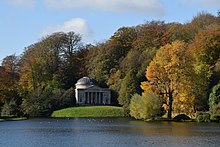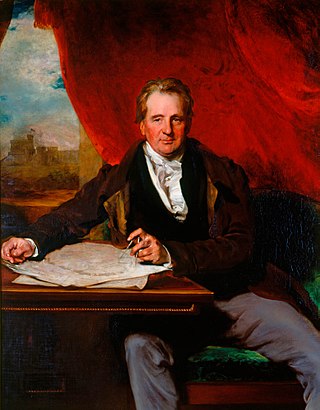
This is a list of notable English landscape gardens .

This is a list of notable English landscape gardens .











Lancelot Brown, more commonly known as Capability Brown, was an English gardener and landscape architect, who remains the most famous figure in the history of the English landscape garden style. He is remembered as "the last of the great English 18th-century artists to be accorded his due" and "England's greatest gardener".

In architecture, a folly is a building constructed primarily for decoration, but suggesting through its appearance some other purpose, or of such extravagant appearance that it transcends the range of usual garden buildings.
James Wyatt was an English architect, a rival of Robert Adam in the neoclassical and neo-Gothic styles. He was elected to the Royal Academy of Arts in 1785 and was its president from 1805 to 1806.
Aston is a district of Birmingham, England.

James Paine (1717–1789) was an English architect. He worked on number of country houses such as Chatsworth House, Thorndon Hall and Kedleston Hall.
England is divided by a number of different regional schemes for various purposes. Since the creation of the Government Office Regions in 1994 and their adoption for statistical purposes in 1999, some historical regional schemes have become obsolete. However, many alternative regional designations also exist and continue to be widely used.
The Custos rotulorum, Latin for "keeper of the rolls" within civil government, is the keeper of the English, Welsh and Northern Irish county records. The Custos is also the principal Justice of the Peace of the county and keeper of the records of the sessions of the local courts and, by virtue of those offices, the highest civil official in the county. The position is now largely ceremonial and generally undertaken by the Lord Lieutenant of the county.
Precedence is the order in which the various corps of the British Army parade, from right to left, with the unit at the extreme right being highest.

Charles Eamer Kempe was a British Victorian era designer and manufacturer of stained glass. His studios produced over 4,000 windows and also designs for altars and altar frontals, furniture and furnishings, lychgates and memorials that helped to define a later nineteenth-century Anglican style. The list of English cathedrals containing examples of his work includes: Chester, Gloucester, Hereford, Lichfield, Wells, Winchester and York. Kempe's networks of patrons and influence stretched from the Royal Family and the Church of England hierarchy to the literary and artistic beau monde.
The following is a list of articles about the geology of English counties:

The War Damage Commission was a body set up by the British Government under the War Damage Act 1941 to pay compensation for war damage to land and buildings and " 'Fixed' plant and machinery", throughout the United Kingdom. It was not responsible for the repairs themselves, which were carried out by local authorities or private contractors.
The 2003 Cheltenham & Gloucester Trophy was an English county cricket tournament, held between 29 August 2002 and 30 August 2003. The competition was won by Gloucestershire who beat Worcestershire by 7 wickets at Lord's.

Sir Jeffry Wyatville was an English architect and garden designer. Born Jeffry Wyatt into an established dynasty of architects, in 1824 he was allowed by King George IV to change his surname to Wyatville. He is mainly remembered for making alterations and extensions to Chatsworth House and Windsor Castle.